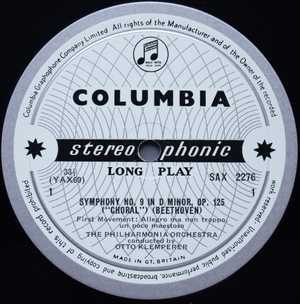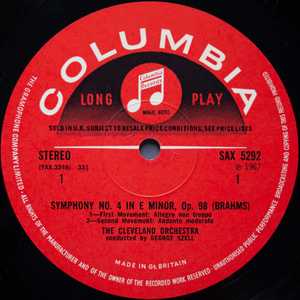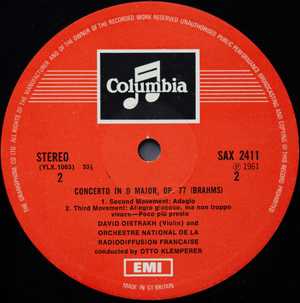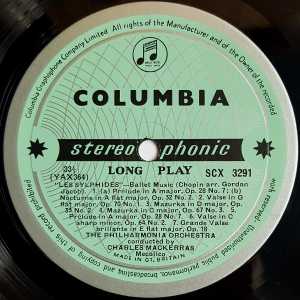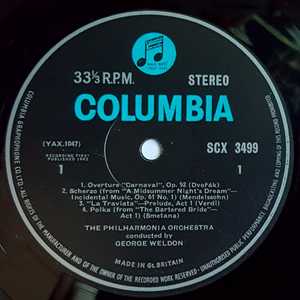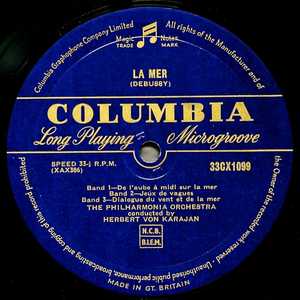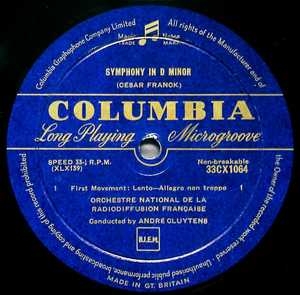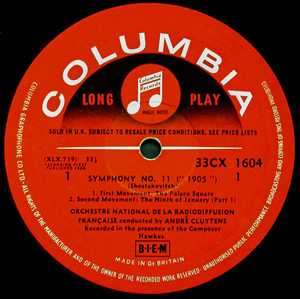Guide to Collecting: Columbia
This is, of course, the English Columbia Company, owned by EMI, that I am talking about. It is an entirely different Company from the US Columbia Company.
Columbia started issuing LPs in 1952, and started issuing stereo LPs on the SAX label in 1958. Columbia SAXs are a superb-sounding series, much prized by collectors. SAX numbers run from SAX 2252 to SAX 2589, and from SAX 5251 to SAX 5294.
Table of contents
Columbia SAX labels
Silver/blue
The first label is the original silver/blue label, pale blue with silver curved lines.
The highest number SAX silver/blue label is SAX 2538, Handel conducted by Gonnenwein, issued in 1964. But there are some earlier SAX numbers where there is no silver/blue label. If you'd like to know what the original label is for any SAX you can look at my original labels resource.
Red semi-circle
The second label is the red semi-circle label.
This is the original label for SAX 2526, Szell conducting Brahms, with Leon Fleischer & SAX 2527, Walton Shakespeare Film Scores, both issued in 1964. The next original semi-circles are SAX 2532, SAX 2534, SAX 2536, SAX 2537. From SAX 2539 onwards no silver/blue label exists, so the semi-circle label is the original. So all the SAX 5000 series have semi-circle as their original label. The first in the SAX 5000 series is SAX 5251, issued in 1966. The highest SAX is SAX 5294, Szell conducting Brahms Symphony no 3, issued in 1968.
Magic notes
The third label is the red label with musical notes and the word “Columbia” in a black rectangle.
There’s various ways of describing this one. “Magic notes label”, “magic notes in stamp” label, “rectangle label”, “stamp label”. This is the second label for all SAXs that have the semi-circle label as the original, and the third label for the early SAX’s that have a silver/blue label as the first label.
Which Columbia SAX label should you buy?
I do hear some differences between blue/silver labels and semi-circle labels where the semi-circle is the second label. But that doesn’t necessarily mean the that the blue/silver labels are the “best”. You usually get a quieter surface on semi-circle label records than blue/silver label ones, and their sound quality is also superb. And of course when the semi-circle is the second label, it’s much more reasonably priced than the original silver/blue. I have sometimes been disappointed by the stamp label particularly when it’s the third label for that issue. When it’s the second label I’m less likely to be disappointed by the sound. They are very good value, particularly when the original is extremely expensive.
Columbia SCX labels
SCX is a Columbia stereo label, very similar to SAX in sound. Most of the Columbia SCX issues are non-classical, but there are some outstanding classical issues too. Some of the notable conductors on this label are Cluytens, Henry Krips, Mackerras, Szell & Weldon.
Silver green
The first SCX label is very similar to the silver/blue SAX label, but the background is pale green instead of pale blue
The first SCX is SCX 3251, Waldteufel Waltzes, conducted by Henry Krips, issued in 1958, and the last original silver/green label I've had is SCX 3467, Bach Organ Recital played by Edouard Commette, issued in 1962
Turquoise/black
The second SCX label is the original turquoise/black label
The first original turquoise/black label I have had is SCX 3499, Weldon conducting Tchaikovsky's 1812 Overture, issued in 1963
The last original turquoise/black label I have had is SCX 6132, Judith Raskin singing Mahler Songs, issued in 1966
Which Columbia SCX label should you buy?
I would recommend all of them, as the sound quality of the silver/green label is very similar to SAX silver/blue sound quality. And the turquoise black label is equivalent in sound to SAX semi-circle label.
Columbia 33CX Mono labels
UK Columbia's mono 33CXs was an EMI label, just like the stereo SAXs.
The fist 33CX was issued in 1952, 33CX 1001, Karajan conducting Richard Strauss's Till Eulenspiegel & Don Juan. The original label is blue/gold, which was used from 1952 until 1963. The last blue/gold label that I know of is 33CX 1859, the Drolc Quartet playing Beethoven. By 1963 we are well into the stereo era of course.
The very earliest 33CX issues have a heavy, flat pressing, this pressing is quite rare. The label says "Non breakable" above the record code. (A few don't say "Non breakable"), and there is a deep grove about 1cm from the edge of the label.
Most 33CX pressings are groove guard pressings. The rim has a slightly raised area, If you feel the edge of the record through the inner sleeve you can feel the raised rim. This was to protect the record when an auto-changer turntable was used. Auto-changers had a long spindle, and several records could be loaded onto the spindle, and when one finished playing the next record would drop on top of it. This was clearly very useful for 78rpm records, when a symphony would need 10 or 12 records, but autochangers continued to be used into the 1950s and even the 1960s. Sometimes we find an opera set that has "automatic coupling" so that the first record has sides 1 & 6, the second has sides 2 & 5, and the third has sides 3 & 4. That takes a bit of concentrating when you're playing the set, to play the correct sides!
The second 33CX label is the red semi-circle label. This label is identical to the SAX semi-circle label, except that it doesn't say "stereo" to the left of the label, under the white line. The first original semi-circle 33CX that I know of is 33CX 1863, but there may be earlier numbers that have no blue/gold label. Many of the 33CXs issued from 1958 onwards were also issued in stereo, but there were still many mono-only 33CXs issued. The last mono-only 33CX that I know of was 33CX 1888, Charles Rosen playing Ravel.
Which Columbia 33CX label should you buy?
Splendid sound on all of them. As with other labels, the later vinyl pressings are likely to be quieter than the earlier ones, due to improvements in the vinyl. Semi-circle labels of expensive blue/gold issues are very good value.
